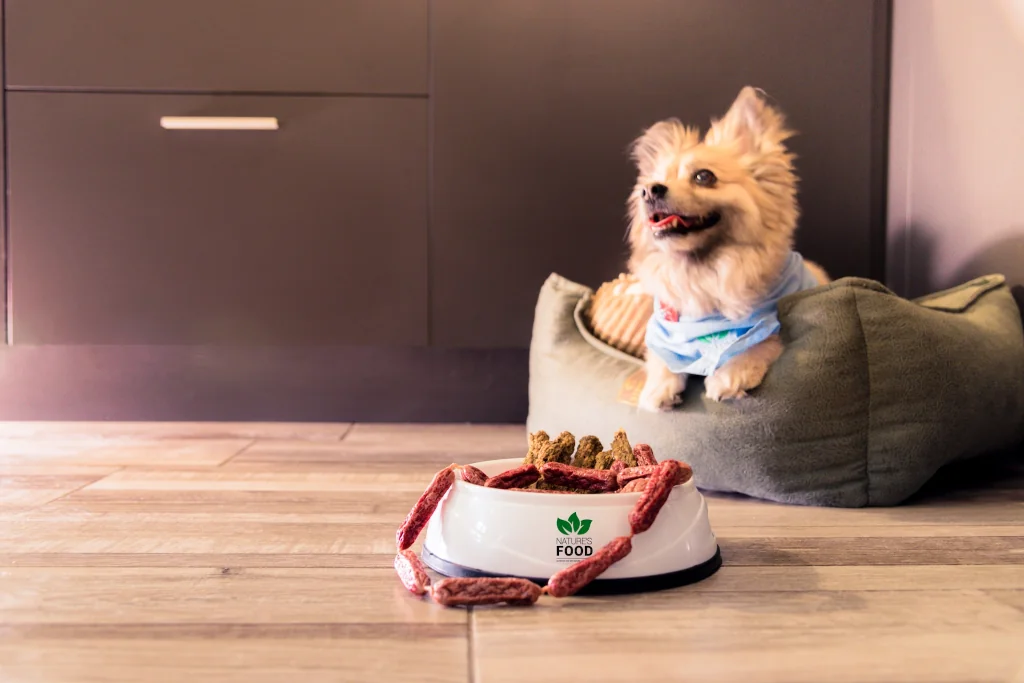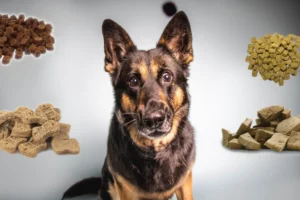Disclosure: We may earn a commission from helpful, relevant links in our content. No cost to you. See our privacy policy.
Seeking the healthiest diet for your beloved pup? You’re in the right place.
Often, dog owners struggle with the question of fat—how much is too much, and what type should they feed? These questions are both essential and complex.
This post will dive into the importance of fats in your dog’s diet, guiding you through the types, quantities, and sources suitable for your canine friend. Stay with us as we navigate the intricacies of dog nutrition, offering expert advice to keep your dog’s health in peak condition.

Why are Fats Vital in a Dog’s Diet?
Let’s clear the air right away: fats are absolutely crucial in a dog’s diet.
They’re not just for making kibble tastier, they play a vital role in overall health. Fats provide the most concentrated source of energy for your dog.
They aid in absorbing vitamins A, D, E, and K, help maintain nerve function, and contribute to the health of skin and coats. Just like us, dogs need certain fatty acids – namely omega-3 and omega-6 – that their bodies can’t produce naturally.
That’s why their diet needs to include a reliable source of these essential fats.
What Percentage of a Dog’s Diet Should Be Fat?
So, how much fat does your dog actually need?
While there isn’t a one-size-fits-all answer, certain guidelines can be followed. According to the National Research Council, fats should make up at least 5.5% of an adult dog’s diet and around 8.5% for puppies. However, this can vary based on factors like age, activity level, and health status.
For example, let’s consider a medium-sized adult dog’s meal, which totals 500 grams. If we stick to the 5.5% guideline, this would mean about 27.5 grams of this meal should be fat. If this were to come from a source such as chicken fat, which has roughly 99.5% fat content, you would need to include about 28 grams of chicken fat in your dog’s meal to meet the fat requirement.
Here is the daily recommended Protein and Fat intake for your dog from the National Research Council:
| Puppies (12 lb, 33 lb at maturity) | Adult Dogs (33 lb) | Pregnant/Nursing Dogs (33 lb with 6 puppies) | |
| Total Fat | 21 g | 14 g | 29 g/67 g |
| Crude Protein | 56 g | 25 g | 69 g /158 g |
So, if you have a medium-sized adult dog that is fed a meal totaling 500 grams, the 5.5% guideline would indeed suggest a fat content of about 27.5 grams. This is assuming the dog’s meal is based on dry matter content. This might look like a contradiction to the 14 grams guideline, but the 14 grams is for the actual amount of fat the dog consumes and can metabolize in a day.
So the 5.5% fat is referring to the fat content in the dry matter of the food. If your dog food is not 100% dry matter (which it wouldn’t be unless you’re feeding a strictly dry kibble diet), the amount of food (and thus, the amount of fat) your dog consumes per meal will be higher.
Remember, a highly active dog might need more fat for energy, while a senior or overweight dog may require less. Always consult with your vet to determine the ideal fat intake for your unique furry friend.
Which Sources Have Healthy Fats for Dogs?
Some excellent sources of healthy fats that you can safely incorporate into your dog’s diet include:
- Fish. Certain fish like salmon and mackerel are packed with beneficial omega-3 fatty acids.
- Fish Oil. If your dog isn’t a fan of fish, fish oil supplements are an excellent alternative.
- Flaxseed Oil. This is a plant-based source of omega-3 fatty acids, suitable for dogs with certain dietary restrictions.
- Chicken Fat. An excellent source of energy and adds a flavor that dogs love. It also contains arachidonic acid, essential for dogs.
- Olive Oil. Rich in monounsaturated fats and antioxidants, a small amount added to their meals can do wonders for their coat.
Remember, introducing new food items should be done gradually and under your vet’s guidance to ensure your dog adapts well.
For those who would rather opt for commercially available products to ensure their dogs are getting the necessary fats in their diet, a few options stand out for their quality and nutritional balance.
The Wellness CORE Grain-Free Original Recipe is a great choice. It boasts high-protein content and nutrient-dense superfoods, all while maintaining a healthy fat level. It’s especially rich in Omega-3 from salmon oil, which supports brain development and promotes a healthy coat and skin.
Additionally, for those looking for plant-based options, V-dog Kind Kibble Vegan Dry Dog Food is a remarkable choice. This product is 100% plant-based, and it contains flaxseed and peas, providing an excellent source of omega-3 and 6 fatty acids.
And for owners wanting to supplement their dog’s diet with additional healthy fats, Nordic Naturals Omega-3 Pet Soft Gels is a worthwhile consideration. These are specially formulated with omega-3 fatty acids derived from fish oil, supporting your dog’s heart, skin, coat, joint, and immune system health.
Which Fats to Avoid Giving Your Dog?
While fats are essential, not all are created equal. There are a few types of fats and sources you should steer clear of for your dog’s health:
- Trans Fats. Just like in human nutrition, trans fats, found in many processed foods, are a no-go for dogs. These fats can lead to inflammation and other health issues.
- Certain Plant Oils. While some plant-based oils are beneficial, others like corn and soybean oil can be high in omega-6 fatty acids, which can cause an imbalance if not counteracted with enough omega-3s.
- Leftover Grease and Fat Trimmings. Tempting as it might be to give your dog leftovers from your meal, avoid giving them grease or fat trimmings. These can lead to pancreatitis, a painful and potentially dangerous condition.
- Fast Food or Fried Food. These foods often contain unhealthy fats and can lead to obesity and other health problems in dogs.
Remember, it’s all about balance. Ensuring your dog’s diet includes the right types of fats, in the right proportions, will help them thrive.
What’s a Good Fat-To-Protein Ratio for Dogs?
The ideal fat-to-protein ratio in a dog’s diet often depends on the dog’s life stage, lifestyle, and overall health.
As a rule of thumb, for a healthy adult dog, a diet composed of about 20-25% protein and 10-15% fat is often recommended. This means that for every two parts of protein, there should be roughly one part fat.
Let’s convert this into practical figures for a 45lb (20kg) dog, who might consume around 1,000 kilocalories per day. A diet of 20% protein would correspond to around 200 kilocalories from protein, and a diet of 15% fat would correspond to around 150 kilocalories from fat. Given that each gram of protein and fat provides approximately 4 and 9 kilocalories respectively, this equates to around 50 grams of protein and roughly 16 grams of fat.
The ratio can significantly change depending on a dog’s specific needs. For example, working dogs or those with a high level of physical activity may require a diet higher in both protein and fat for sustained energy. On the other hand, older dogs or those with certain health conditions might need a diet lower in fat.
Related: Guide to Protein Needs for Dogs
Let’s take a look at the table of average daily energy needs for dogs (from NRC):
| Type of Dog | 10 lb | 30 lb | 50 lb | 70 lb | 90 lb |
| Puppies (10 lb puppy growing to 33 lb at maturity) | 990 | – | – | – | – |
| Inactive Dogs | 296 | 674 | 989 | 1,272 | 1,540 |
| Adult Active Dogs | 404 | 922 | 1,353 | 1,740 | 2,100 |
| Pregnant Dogs (from 4 weeks after mating until delivery) | 518 | 1,274 | 1,940 | 2,570 | 3,170 |
| Young Adult Active Dogs | 436 | 993 | 1,451 | 1,876 | 2,264 |
| Older Active Dogs | 327 | 745 | 1,093 | 1,407 | 1,700 |
The table above offers a glimpse into the diverse energy needs of dogs based on factors like their weight, age, and activity level. For instance, a young, active 90lb dog may require significantly more energy than an older, less active 10lb dog. The same applies to special cases like puppies or pregnant dogs, which have heightened energy demands.
What does this mean for your pet’s diet? Essentially, it underlines the necessity for personalized diet plans. The right balance of fat and protein hinges on more than just a set ratio – it’s also about meeting your dog’s overall energy requirements in tune with their individual lifestyle. This is where a vet’s guidance becomes indispensable in ensuring optimal health for your furry friend.
How to Add Healthy Fats to Your Dog’s Diet?
Adding healthy fats to your dog’s diet doesn’t have to be complex. It’s about diversity and balance. You’re likely already aware of the benefits of omega-rich foods like fish or flaxseed oil, but here are a few unique tips to implement in your dog’s diet:
- Explore Exotic Oils. Camelina oil, for example, is a lesser-known source of omega-3 and vitamin E that can be a healthy addition to your dog’s diet.
- Cook with Tallow or Lard. These are sources of saturated fats which are essential for your dog’s body functions, especially for less active dogs.
- Introduce Green-Lipped Mussels. A novel source of omega-3, they’re great for reducing inflammation and are usually available as a powder that can be sprinkled over food. They have been found to help arthritic dogs with joint pain and improve mobility.
In general, try to consider rotational feeding. This practice involves regularly rotating the sources of fats (and proteins) in your dog’s diet to provide a variety of nutrients and prevent the development of food allergies. One meal might be chicken-based, the next might be fish-based, and so on. This approach helps ensure your dog gets a diverse range of fats and other nutrients to support overall health.
Finally, remember that adding fats also means adding calories. It’s essential to adjust portion sizes to ensure your dog maintains a healthy weight. The advice of a vet or a pet nutritionist can be invaluable in navigating these dietary adjustments.
Related: Good & Bad Carbs for Your Dog
Fat Content on Dog Food Labels
Dog food labels, with their percentages and different names for fats, can seem daunting. However, they’re easier to understand than you might think. Look out for the fat content, listed as a minimum percentage.
For instance, if it says ‘Crude Fat (min) 10%‘, it means that there is at least 10% fat in the food. This percentage is based on the food’s dry matter, not including moisture.
Pay close attention to the type of fat mentioned. Labels might list ingredients like “animal fat” or “poultry fat,” but the more specific, the better. For instance, “chicken fat” is a more defined source and can give you a better idea of what you’re feeding your pet.
In addition, some dog food labels may also include omega-3 and omega-6 fatty acids. These are both beneficial, but the ratio is crucial. Generally, a ratio of omega-6 to omega-3 fats between 5:1 and 10:1 is considered good for dogs. However, according to NRC’s book, the optimal ratio can vary depending on the specific types of fatty acids included in these categories and their unique metabolic impacts.
Some people may think that “fat-free” is the healthiest option for dogs, similar to dietary trends in human nutrition. However, it’s important to understand that dogs require a certain amount of fats for their overall health and wellness. A “fat-free” diet could lead to deficiencies in essential fatty acids, leading to health issues such as a dull coat, dry skin, and more severe problems like a weakened immune system.
So, while it’s crucial to monitor and manage the amount and type of fats in your dog’s diet, completely eliminating them would do more harm than good.
Remember that balance is key, and when it comes to fats, quality trumps quantity. And if ever in doubt, consult with your vet or a pet nutritionist – they are there to guide you in providing the best care for your furry friend. It’s okay to ask for help, and it’s even better to learn and grow along with your pet. After all, as we care for them, they teach us invaluable lessons about love, life, and, yes, even diet. So here’s to healthier, happier dogs, one meal at a time!
FAQs
How much fat should my dog eat?
The amount of fat in your dog’s diet should ideally hover around 5.5% of the total dietary intake. However, this might change based on your pet’s age, activity level, and overall health status.
How much fat should be in homemade dog food?
For homemade dog food, aim for a similar fat content as commercial foods, about 5.5% of the total diet. Make sure to use high-quality sources of fat, like lean meats, fish, and certain oils, ensuring your dog gets a balance of essential fatty acids.
Can my dog get too much fat from treats?
Dogs could consume a lot of fat if their diet is not controlled, especially with treats. Treats should not make up more than 10% of a dog’s daily caloric intake. To maintain a balanced diet, choose low-fat, high-protein treats and adjust your dog’s regular food intake to account for the additional calories.
Is there a risk of heart disease if my dog eats too much fat?
Yes, dogs consuming an excessive amount of fat can risk developing health problems, including obesity and pancreatitis. These conditions can, over time, lead to heart disease. It’s vital to provide a balanced diet and monitor your dog’s weight and overall health regularly.
Can I use vegetable oil to increase fat in my dog’s diet?
Vegetable oil can be used sparingly to increase fat in your dog’s diet, but it should not be the primary source. Oils like flaxseed oil and fish oil are more beneficial as they provide a healthy balance of omega-3 and omega-6 fatty acids.
Alex, a passionate animal lover, has experience in training and understanding animal behavior. As a proud pet parent to two dogs and three cats, he founded AnimalReport.net to share insights from animal experts and expand his knowledge of the animal kingdom.




